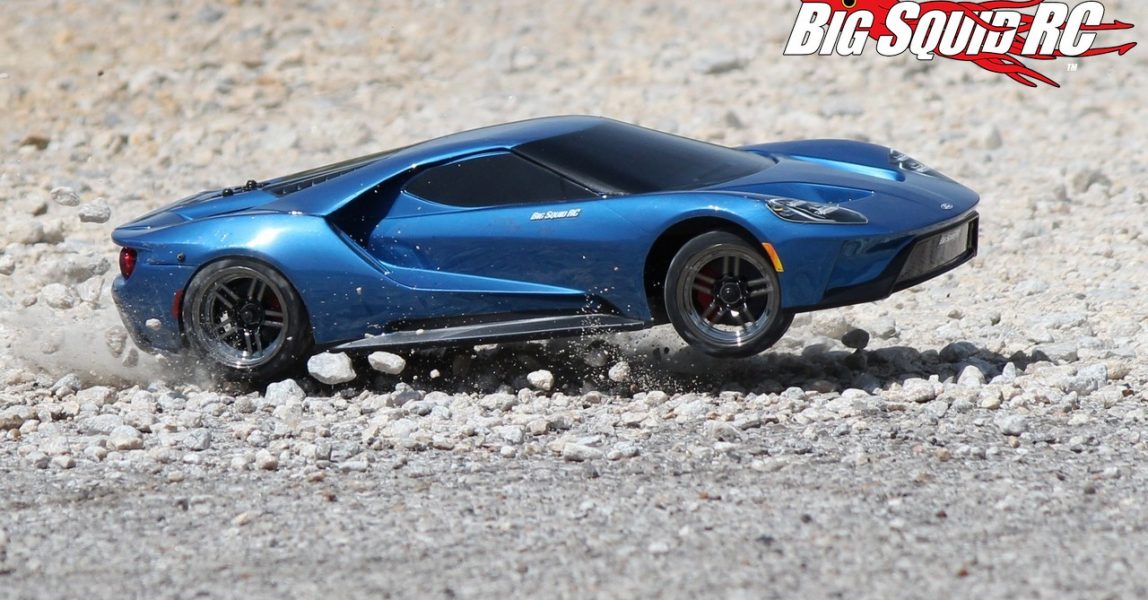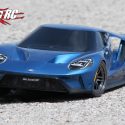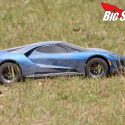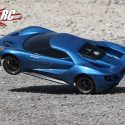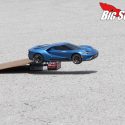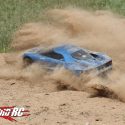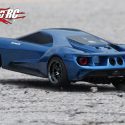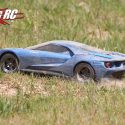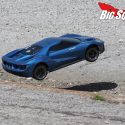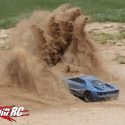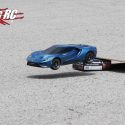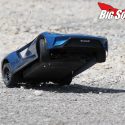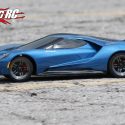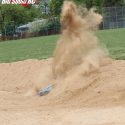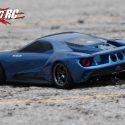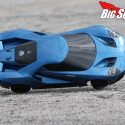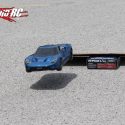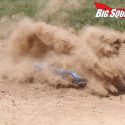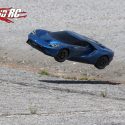Traxxas made huge news in early February when they announced the Ford GT. At a time when on-road had been in decline for years, Traxxas rolled the dice with a hot looking Ford GT body and an all new 4-Tec 2.0 chassis underneath. Can the Ford GT breathe some much needed life back into the on-road scene? How well does it drive? Can it take the hardcore beatings handed out by a typical basher? Keep on reading to find out what we thought of the new Traxxas Ford GT…
From: Traxxas
Direct Link: Ford GT
Unboxing Pictures: BSRC Unboxes The Ford GT
Review By: Cubby
Photography By: Tim Mohr
Specs:
RTR or Kit: RTR
Age: 14+
2wd or 4wd: 4wd
Shaft or Belt: Shaft
Electric or Gas: Electric
Waterproof: Yes
Scale: 1/10th
Length: 17.6″
Width: 7.9″
Wheelbase: 10.1″
Weight: 3.2lbs
Motor: Titan 12 turn brushed 550
Speed Controller: Traxxas XL-5
Low Voltage Cut-off: Yes
Radio: Traxxas TQi with TSM receiver
Differential: Limited slip, hardened steel
Slipper Clutch: No
Driveshafts: Metal bones to the wheels
Overall Drive Ratio: 9.49
Shocks: Oil filled, plastic bodies and caps
Servo Saver: On servo output
Screws: Metric, hex
Spur/Pinion Pitch: 48
Bearings: Yes
Tires: Traxxas Response, rubber with inserts
Battery: Not included
Part Number: #83056-4
Warranty: 30 days on electronics
Bashing Specs:
Front wheel travel: 0.6″
Rear wheel travel: 0.6″
Wheelie on demand: No
Backflip off ramps: No
Stability Control: Yes, Traxxas TSM
Sound Module: No
Self-Righting: No
FPV: No
Top Speed (measured by BSRC on 2S 5800 LiPo stock pinion): 25 mph
Runtime (measured by BSRC on 2S 5800 LiPo): 27 minutes
Street Price: $299
Primary Competition: Going up against the Traxxas are other 1/10th scale RTR on-road cars from various manufacturers.
What’s Needed To Complete: Not too much actually. You’ll need four AA cells for the transmitter, a battery to power the car, and a battery charger.
Build Quality: After pulling the Traxxas out of the box we had our entire crew look the car over for defects in build quality. We found none. All the bolts were tight but not stripped, the wheel nuts were super tight, the gear mesh was spot-on, and the shocks were properly filled and not leaking.
Test Drivers: A whole lot of guys raised their hand when it was time to test the Ford GT, the list includes- Editor Brian, Iron Mike, Robbie G, Sam Da’ Noob, THE RC Kid, Hawaiian Chris, T-$$$, various muggle first time drivers, and yours truly.
Test Venues: We ran the Traxxas at a bunch of different venues. Being an on-road car, having a spot to run was very easy to find in an urban environment. Of course we hit our normal Costco parking lot, in addition to driving it at several city parks. And yes, we even got in some laps on our local 8th scale dirt off-road track.
Set-up Notes: Per the norm at BSRC, we ran the car bone stock. We did however use Traxxas AA batteries in the transmitter and a Traxxas 2S 5800 LiPo battery with iD connector to power the car. Charging was taken care of by a Traxxas EZ Peak Live.
Turning: For a bashing oriented on-road car, the new 4-Tec 2.0 chassis turned really well. No, it didn’t turn as well as a high end touring car, but the front wheels did a solid job of going where they were pointed while the rear end typically only stepped out when asked to do so. For example, going into a “normal” corner on pavement you would let off the gas and turn-in. The front wheels would nearly always stick, the chassis would lean a bit, then at apex you could pound the throttle and come flying out of the corner. Simply put, the chassis was easy to drive and confidence inspiring. In super tight 180 corners you could give the car a tap on the brake and the rear end would swiftly rotate around as desired. The GT did turn slightly better to the left than the right because of its layout design, but overall it was a pleasure to drive in the corners.
Jumping: Yes, we know you aren’t supposed to jump on-road cars, but it sure is fun once in a while. We found that the Ford GT flies like most 1/10th on-road cars- not very well. The tires don’t have much rotating mass, thus making trigger inputs mostly ineffective. Also, air loves to get under the body and make it fly like a kite. For those of you that love getting big air, you don’t want the Ford GT (or any other on-road car for that matter).
Bumps/Whoops: Just like any 1/10th scale on-road car, the Traxxas doesn’t have a lot of wheel travel and runs fairly small tires. So no, you won’t be blowing by guys through the whoop section at your local off-road track. What the Traxxas does come with is suspension tuned for driving on real world pavement. Once again, whoever the set-up guy at Traxxas is was pretty close on settings. We found the pistons, oil, and spring settings to be very well done for general on-road bashing. Over larger pavement joints and pot holes the rear of the car would kick up and to the side, not something that was unexpected for the amount of wheel travel and ground clearance available. When driven on-road, the Traxxas soaked up general bumps as good, or better, than any 1/10th on-road car we’ve tested, a testament to the car’s design and shock settings.
On-Road: Now here we go, this is what the Ford GT was designed for. We found the Traxxas to be great fun when driven on-road. Its suspension settings were very close for general on-road bashing and you did not have to worry about breaking if you accidentally tapped a curb or mailbox post. Our test drivers praised the car for being so easy to drive. First day noobies were able to wheel the car with confidence, while long time drivers enjoyed driving it like they stole it. The car would only traction roll if it caught a rut or rock in a corner, otherwise you could drive/turn it as hard as you wanted and it just kept hauling.
Grass: Yes! You can drive the GT in very short grass. No! Like most on-road cars it gets stuck very quickly when the grass gets a couple of inches tall. If most of your driving involves grass, skip the GT and look for something with more ground clearance and larger tires.
Tires: We liked the stock tires. The tires were soft, not crazy soft, not winning the IFMAR worlds soft, but soft enough to give good traction on pavement while still being hard enough to not wear out in a half dozen runs. The tires had nice foam inserts and looked cool, generally we thought they did a solid job.
Power: With its brushed 12 turn Titan power plant, the GT didn’t have the insane power of a brushless car, but it still had decent power, perhaps even perfect power for a first time driver. The GT didn’t have a lot of rotating mass, plus it was fairly lightweight overall, so the 12 turn Titan gave the car a lot of punch right off the line. Low end was solid then it blitzed quickly through its mid-range. The GT topped out at 25 mph so it didn’t have a lot of yank on top, but from watching various first timers wheel the car, it had more than enough power to give them a taste of “Wow, this is quick!”. For seasoned drivers there is enough power to keep things interesting, although if you drive in large areas you’ll be looking to do some mods for more top speed.
Radio: We didn’t have any issues with the included TQi radio. Its ergonomics seems to work fine for a wide variety of hand sizes and we never had an issue with range for glitching. The TQi isn’t a high-end race unit but got the job done for general bashing.
Broken Parts: And… our test car still doesn’t have a broken part on it. Not that we didn’t try, we did “all sorts of stupid” to our Ford GT, but it was one of the rare cars that we had to simply give up on trying to break. Now, our test car is tweaked and bent in several areas, but it still drives. We managed to taco the center driveshafts after slamming it full speed into a brick wall (multiple times). The front clip seems to be a bit loose after multiple 2 story roof jumps. And the final issue we had was one of the front dog bones became misaligned with the outdrive on the diff output after pounding a curb WFO at an angle. Yet our test car lives, one of the very few that has ever driven away from one of our reviews.
Misc Notes (AKA- The Best Part Of The Review):
We found that the motor ran quite hot. Our ambient temps ranged from 70 to 85 during testing and we consistently saw motor temps in the 170 degree range. We did not break in the motor, should you take the time to do so you’ll enjoy lower temps and more power. So while you might feel compelled to throw a few more teeth on the pinion to get more top speed, our test unit indicated that probably isn’t a good idea unless you are only making short speed passes or are driving in cold temps.
Ever notice how all the high-end touring cars come with belt drive? The Traxxas comes with a shaft, and for good reason- belts suck at bashing. Belt drive cars are awesome for perfectly prepped race tracks, but shaft drive is simply more durable when the going gets really tough. And while we did managed to taco the center driveshaft in our car, it was quick and easy to straighten.
Oh ya, the Ford GT comes stock with the Traxxas Stability Management system. The car drives well without it, but we found ourselves running TSM set at about 50%. With the TSM turned on you really start feeling like Superman, able to pull off cool maneuvers like you are a pro driver. Btw, when we turned the TSM all the way up the car started to wiggle on its own, showing that setting was just too sensitive to be used.
One more note on the TSM, with it set properly the Ford became an awesome drift machine. We had a blast drifting the car around parking lots and on hard packed dirt.
We didn’t expect the body to live very long with all the abuse the car was getting. We were wrong. The body actually held up much better than expected. Yes, our body did get broken in various areas over time, but not without some severe beatings to do so.
The new battery strap is exceptionally easy to use and it doesn’t require a body clip. We found it worked really well, except for two story roof jumps where the battery pack would come loose due to all the g forces.
The car comes with some basic tools, enough to cover normal wrenching. The tools aren’t high-zoot, but they are enough to keep someone new to the hobby up and going.
One thing we did not notice during our initial inspection was the servo saver. Ours came set too tightly and wasn’t working at all. Nope, we didn’t change the setting to see how long the servo would live, and while the servo did suffer some damage, it still works.
Speaking of the included servo, it isn’t fast but has more than enough torque to get the job done.
One of the biggest things we noticed during our unboxing was how little slop the car had. Most RTRs have a lot of slop in the steering and suspension, our Ford GT did not. No, there wasn’t any binding, just nice, smooth, slop-free performance.
Our car didn’t come with a foam spacer for the battery tray.
While the body posts still use body clips, they are fairly stealth and work well. The car comes with black body clips to help them blend in and the body clips are somewhat hidden for greater scale realism.
With so much attention to detail being paid on scale realism, one of our testers commented on why didn’t the car come with rear view mirrors. We don’t know the real reason, but we do know that you can get the full scale Ford GT without them, so not coming with them could actually be considered realistic.
The rear corners of the body can occasionally get sucked in by the rear wheels. We used a pair of handy dandy body scissors to do some light trimming and never experienced the problem again.
The Ford GT just might win the award for the best tracking RTR ever. The Traxxas tracked amazingly straight. In fact, I don’t think we once ever had to adjust the steering trim, very impressive.
We realize that most of you won’t be running your Ford GT in rocks or dirt, but if you do we found that rocks can sometime clog up the steering. The fix is simple, just turn the car over and let the rocks fall out.
The speedo allows you to go from full reverse to full forward instantly. This is good for tricks and trying to pop wheelies, but hard on drive-line parts.
There isn’t a ton of adjust-ability on the Ford GT. The top of the shocks have two holes, the bottom just one, and the car uses solid tie-rods everywhere. Hey, that’s why the aftermarket exists right?
Best Mod: Rare. It is quite rare when the BSRC Bash Crew doesn’t immediately scream for this upgrade or that one on a test car. However, the Traxxas is very solid right out of the box. After talking for a few minutes to talk it over, our first recommended upgrade would be installing a faster Hitec servo. A faster servo will only make the good handling Ford GT drive better. Otherwise, if you are a seasoned hobbyist looking for more yank up top, dropping in your favorite 540 sized brushless system will definitely make it into a speed demon.
Summary:
A = Outstanding/Best in Class, B = Above Average, C = Average, D = Below Average, F = Horrific
Time To Bash: B Set-up was fast and easy on the Traxxas. Charge up a pack for the car, pop in some AAs for the transmitter, then it was ready to jam.
Workability: B We did some wrenching on the Traxxas and found it very simple to work out. It uses a nice open layout and good quality metric hardware.
Car Show Rating: A This is where the Traxxas knocks it out of the park. The body is outstanding, in fact, arguably the best looking to ever hit the market on an RTR on-road car. Also, the wheel and tire combo was really on point. We were constantly being approached by people wanting to look at it, even people who knew nothing about the hobby thought it was a gorgeous car.
Bash-A-Bility: A We very, VERY, rarely award an “A” in this category, but the Ford GT held up like a tank. To this day, even after all our stupidity, we have yet to break a part on it. This is a great car for noobies as they can accidentally slam pretty much anything in sight and not have to worry about fixing the car afterwards. The big front bumper is great at soaking up big hits and the car’s blend of plastic seems to be spot on for durability.
Fun Factor: A While the car didn’t have insane brushless power, that didn’t keep us from having a fantastic time with it. It was a combination of head turning looks, Sherman tank durability, and sweet handling that consistently kept a smile on our test driver’s faces.
Handling: B No, the Traxxas Ford GT was never designed to win IFMAR world championships, it was designed to kick ass in your cul-de-sac or local parking lot. For that purpose it handles extremely well, and perhaps more importantly, is exceptionally easy to drive.
Value: B Coming in at just under $300 all reviewers felt that the Ford GT was a solid value. It has decent electronics for a RTR and is a good package for the price.
Parts Availability: N/A We can’t give the GT a score yet in this category because the car has yet to be released. However, one of the biggest things that Traxxas is known for is parts support, so we would expect the GT to have plenty of spares available once they actually start shipping.
BigSquid Rating: A- We don’t own any crystal balls here at BigSquidRC but we do know that Traxxas is going to sell an amazing amount of their new Ford GT. The new 4-Tec 2.0 chassis was intelligently designed and well executed, while its Ford GT body is far and away the best looking to ever come out of the Traxxas factory. The Traxxas was one of the toughest cars we’ve ever tested and was a complete blast to drive, we can very highly recommend it to you.

